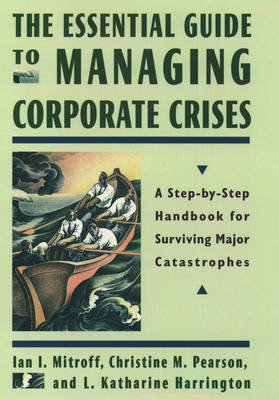Syringes allegedly found in cans of Pepsi, deaths from Jack-in-the-Box hamburgers, kickbacks from Honda dealers to corporate executives, racial discrimination by Dennys employees: a crisis can strike a firm at any time and no company is immune. But now, when disaster hits, managers can turn to The Essential Guide to Managing Corporate Crises. Enhanced with unique interactive software (for Macintosh) that can be used both as part of a training programme and as a working guide during the crisis itself, this essential handbook shows executives, including those with no experience in this area, how to assess their company's strengths and vulnerabilities before a crisis ever happens, how to handle a crisis effectively once it hits - including what to do if there has been no pre-crisis planning - and how to learn from a crisis so they can minimize future problems. No other guide provides as much necessary information about crisis management in one convenient volume.
Mitroff, Pearson, and Harrington, all highly regarded authorities, provide an overview of the entire crisis management process, cover thoroughly what to do before and after a disaster, and highlight the knowledge and training needed to implement an effective programme. They lay out the key management actions and decisions that executives must face to handle a major crisis, and provide a questionnaire that helps managers assess their firms' overall level of crisis preparedness. There are many ways that firms can find themselves in trouble, and the authors cover them all, ranging from disasters that threaten the public image of a company or product line, to financial catastrophes, to industrial problems that endanger consumers, employees, the community, or the environment. Along the way, they are careful to give managers many real-life examples, to make each point crystal clear. In discussing media relations, for instance, they show how Johnson & Johnson, during the Tylenol tampering tragedy, improved its credibility and achieved customer reassurance through candor with the media.
And they contrast Johnson & Johnson's successful response with Exxon's arrogant response to the Valdez oil spill, and show how US Air's CEO might have responded more effectively to questions about his airline's safety standards. The book also reveals how some companies' solutions to crises only serve to create new problems. For example, Sears sought to avert financial disaster by offering Auto Repair employees a bonus for bringing in more business, a strategy that not only increased revenue, but also led to employees recommending unnecessary repairs to customers, thus tarnishing Sears' reputation. Similarly, NASA introduced a bonus for workers in key programmes who located defects that led to employees discovering non-existent defects to collect the bonus. Based on the authors' years of experience studying crises, teaching courses and conducting seminars in CM, and advising firms during the heat of actual crises, The Essential Guide to Managing Corporate Crises is crucial reading for all key managers and legal personnel in any size private or public organization.
- ISBN10 0195097440
- ISBN13 9780195097443
- Publish Date 23 May 1996
- Publish Status Out of Print
- Out of Print 26 June 2010
- Publish Country US
- Imprint Oxford University Press Inc
- Format Hardcover
- Pages 224
- Language English
